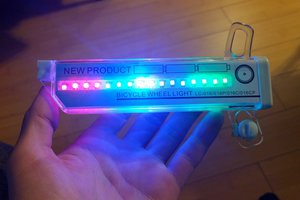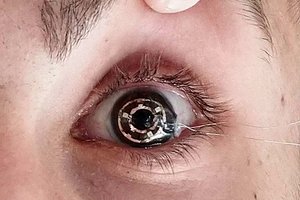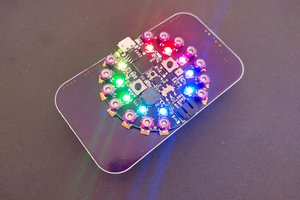To make the experience fit your profile, pick a username and tell us what interests you.
We found and based on your interests.
I bet you still connect your STM32F1 "Blue Pill" boards to your STLink clone with jumper wires, like some sort of caveman, right?
That was annoying me.
Got myself some @oshpark boards.
Soldered it all together.
And, connected!
From the fab, it connects VCC from the STLink from the board. Things IRL are more complex though, so you can cut the VCC trace in between those centre header pins. So like, when you're powering the STM32 externally, you don't power from the programmer.
Along the same lines, finding uses for the million white LEDs.
A 7-segment display!
All covered in paste.
All the components soldered down.
And lit up! It's hard to convey in pictures just how bright these are, but you can see the flashlight effect going on on my hand.
It uses a 74HC595 serial shift register, and I've made a module in Upverter so it's super quick to chain multiple together in a PCB.
Someone donated, at rough estimate, 2 million LEDs to my local hackspace. It was something like 30 boxes full of 5000-count reels of white 3014 LEDs.
Just as a quick test, I did a panel for them. Ten rows of 3 in series.
I forgot to get a picture of them all lit up, but I think I ruined my eyes
Time for a lamp maybe?
These only took 5 minutes or so to build up, with a solder paste syringe and a reflow oven.

No, that kind!
A joule thief is a circuit that pulls as much energy out of a battery is possible, by slowly adding energy into an inductor (to be stored in its magnetic field) and then pulsed out into an LED suddenly when it reaches a threshold.
I wanted to use photodiodes as the energy source, however.
On the right, I stacked up some BPW34 / BW34 photodiodes, (ab)using them as solar cells until they could very slightly light up an LED while directly against some extremely bright indoor lights.
Each cell is about 0.24v open circuit voltage, so I totally guessed and tossed two of them in series on a board.
One more spin on the concept is that I used a surface mount coupled inductor. Honestly not sure how that's going to go, most examples out there are huge toroids and I just don't want that.
Also used a MOSFET instead of BJT, because, efficiency?
With a 5k resistor, it seems to just turn on at 0.55v. It seems to be pulsing slightly, as it should, but it's hard to tell without digging out the oscilloscope, and that's too much work for today. I'm still not convinced it's not powering the LED directly through the inductor, though.
With a 1.3k resistor in there instead, it turns on at closer to 0.47v.
Soldering on the photodiodes, nothing happens in the dim indoor light. I'll check it out again when there's sunlight in, oh, about three months.
Behold, the schematic and PCB that took maaaaybe twenty minutes to lay out, as fast as humanly possible. That's why nothing is straight!
For posterity, I tried to find the most efficient parts possible for this design.
LED: Digkey 475-2709-1-ND
MOSFET: RUJ002YNTCLCT-ND
Inductor: SRF0703-8R2M
So... I also have some proper toroids coming, just to see if they work. I'm open to suggestions for other components/values to play around with.
This is basically just the power section from the upcoming version of #uMesh
With the changes, I kinda wanted to test it all in isolation, in addition to this probably being useful in its own application. There aren't really any dedicated battery charger / power supply with discharge protection going to 3.3v that I've seen. Most of them seem to output 5v.
As an update on this failed experiment, I did another spin with a different concept.
Two PCBs this time, there's the base:
And then the right angled portion:
It's using two different styles to connect the two halves. A set battery connector leaf contacts on one, and PCB copper as a target, connected via a 2mm pitch right angle header, abused to be SMD on both boards.
You can see I was doing some logo experimentation, too. Can't waste good real estate!
Due to postal strikes in my area, I wasn't actually able to get 2mm right angled headers, so I made do with dual straight headers, and bent/snipped contacts as necessary.
Then I taped up one side:
Added magnets:
And then they snap together quite well:
They have a pretty satisfying feel, and seem kinda sturdy. I might try using some cardstock or plastic on the front instead of tape, and a jig to keep the things at 90 degrees while soldering.
Also, I used three magnets only in this one, because I was having a dumb moment and didn't see that you can't have symmetrical polarities with three magnets! Silly.
Anyway, I more or less like the mechanical design, will have to test the reliability now.
Digging stuff out from the archives, this is from 2016
Also crappy soldering from 2016 :)
Design courtesy of @Ted Yapo with his #Ugly FPGA Breakout
I soldered on an LCMXO2-256HC, which is, hands-down, the cheapest fpga you can buy right now, at about $3 in singles. I bought a couple, and also an LCMXO2-1200HC, in case I need something beefier in the future. Same footprint, but more like $11.
I think these footprints might be 0805, but fuck tha police! I got 0603 components! They work fine.
Currently, I have no way of testing this breakout board, though! I don't have a lot of evenings to sit down and figure out the toolchain / programming strategies for a bit.
Testing out a new connector style.
These also required a 3D printed holder for the full test.
Underneath that tape are slots that hold some magnets.
Like so!
The intent is to try to get them to mate cleanly.
The pogopin connectors are these:
https://item.taobao.com/item.htm?spm=2013.1.0.0.6004bf92JzTjHT&id=561256219667
Part numbers PGF25002 and PGF25004.
Spoiler:
They really don't work all that well. The plastic in them melts like butter if they get so much as a peek at a soldering iron, the spring contacts are too stiff to be compressed by any small magnet, and the females sticking out like that result in huge problems trying to get alignment right.
I think I'm going to try something else.
@Kris Winer used this sensor on the #STM32L4 Sensor Tile, and it looks pretty interesting for an application I have in mind.
I was originally, a long time ago, going to use a different electret microphone (the SPM0408LE5H-TB-6), but that was analog output, no amplification, nothing special.
This thing is a complete package, with I2S output. Seems awesome.
@oshpark link:
https://oshpark.com/shared_projects/22CwXvUR
Shown with a Digikey ruler. I'm liking this for scale, I might do it all the time.
Problems:
That hole for the microphone wasn't wide enough to actually be a hole. It was filled up with dried soldermask. A small drill bit cleared that right up. Note to self, make the hole bigger in my footprint. It's currently not a via, and it's probably best to keep it that way so as to not encourage solder to flow into the hole.
Create an account to leave a comment. Already have an account? Log In.
How did you manage to solder the QFN IC on Lattice FPGA board ??
Little bit of flux pen on the pads, then tin them, tiny dab of solder on the ground pad, then a little more flux.
Delicately drop the QFN onto the board, and then blast with hot air, shoving it into rough alignment with tweezers, and then it'll suck itself into perfect alignment.
Sounds complicated, but only takes a second with practice.
Biggest mistake people make is ussing too much solder.
In my case, I blobbed solder paste on the pads with a 25ga hypodermic syringe, placed the QFN on top, then reflowed on a skillet. Works most of the time - occasionally, I've had to re-seat with hot air, because I probably used too much solder. I think the footprint could use a little tweaking - I suspect the tiny square corner pads are a problem. Some other QFN footprints I have seen make these longer to one side, which probably serves to hold a reservoir of solder, allowing you to be a little less accurate with the paste.
Become a member to follow this project and never miss any updates

 Jarrett
Jarrett
 Kevin Arne
Kevin Arne
 Chris
Chris
 deʃhipu
deʃhipu
How about a PCB that adapts screw terminals for STEP, DIR, ENABLE, and GND to the Stepstick / Pololu pinout? Having a row of four screws plugged into Stepstick sockets would make it very easy to use RAMPS and others with big, high power motor drivers.